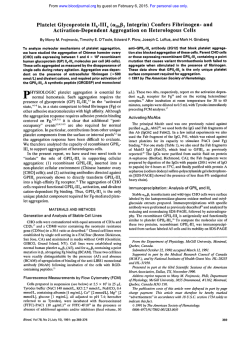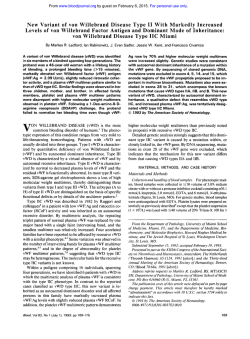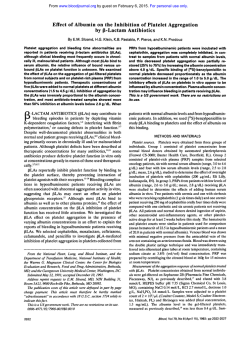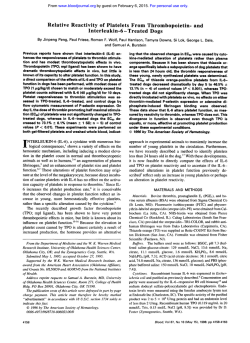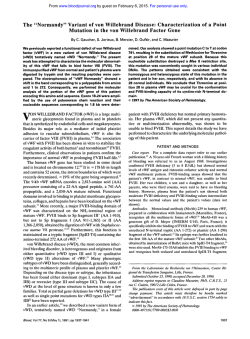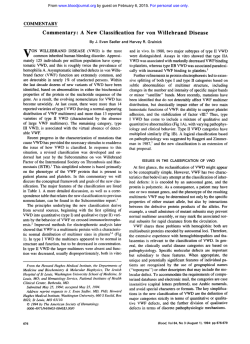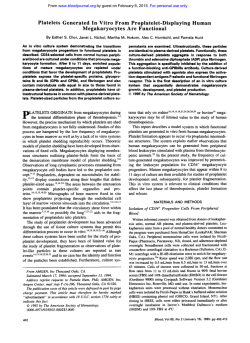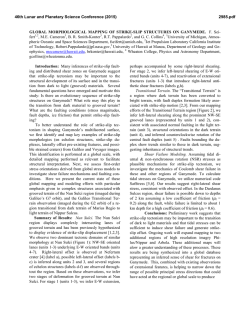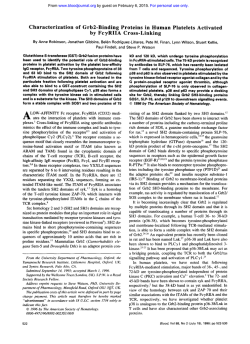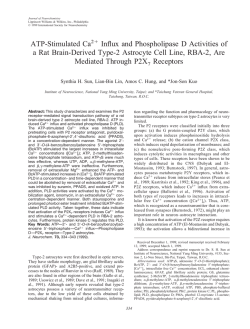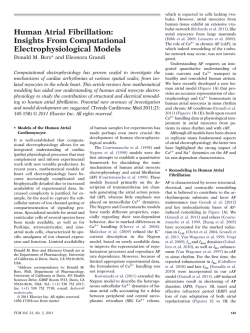
Shear Stress-Induced von Willebrand Factor Binding to
From www.bloodjournal.org by guest on February 6, 2015. For personal use only.
Shear Stress-Induced von Willebrand Factor Binding to Platelet Glycoprotein Ib
Initiates Calcium Influx Associated With Aggregation
By Thomas W. Chow, J. David Hellums, Joel L. Moake, and Michael H. Kroll
Platelets subjected t o elevated levels of fluid shear stress in
the absence of exogenous agonists will aggregate. Shear
stress-induced aggregation requires von Willebrand factor
(vWF) multimers, extracellular calcium (Ca2+), adenosine
diphosphate (ADP), and platelet membrane glycoprotein
(GP)lb and GPllb-llla. The sequence of interaction of vWF
multimers with platelet surface receptors and the effect of
these interactions on platelet activation have not been
determined. To elucidate the mechanism of shear stressinduced platelet aggregation, suspensions of washed platelets were subjected to different levels of uniform shear stress
(15 t o 120 dyne/cm2) in an optically modified cone and plate
viscometer. Cytoplasmic ionized calcium ([Caz+]i)and aggregation of platelets were monitored simultaneously during
the application of shear stress; [Caz+]iwas measured using
indo-1 loaded platelets and aggregation was measured as
changes in light transmission. Basal [Ca2+li was approximately 60 t o 100 nmol/L. An increase of [Caz+]i(up t o >1,000
nmol/ L) was accompanied by synchronous aggregation, and
both responses were dependent on the shear force and the
presence of vWF multimers. EGTA chelation of extracellular
CaZ+completely inhibited vWF-mediated [Caz+]iand aggregation responsest o shear stress. Aurin tricarboxylic acid, which
blocks the GPlb recognition site on the vWF monomer, and
6D1, a monoclonal antibody to GPIb, also completely inhib-
ited platelet responses t o shear stress. The tetrapeptide
RGDS and the monoclonal antibody 10E5, which inhibit vWF
binding t o GPllb-llla, partially inhibited shear stress-induced
[Caz+]iand aggregation responses. The combination of creatine phosphatelcreatine phosphokinase, which converts
ADP t o adenosine triphosphate and blocks the effect of ADP
released from stimulated platelets, inhibited shear stressinduced platelet aggregation without affecting the increase
of [Caz+]i. Neither the [CaZ+], nor aggregation response to
shear stress was inhibited by blocking platelet cyclooxygenase metabolism with acetylsalicylic acid. These results indicate that GPlb and extracellular CaZ+are absolutely required
for vWF-mediated [Ca2+]i and aggregation responses t o
imposed shear stress, and that the interaction of vWF
multimers with GPllb-llla potentiates these responses. Shear
stress-inducedelevation of platelet [CaZ+]i,but not aggregation, is independent of the effects of released ADP, and both
responses occur independently of platelet cyclooxygenase
metabolism. These results suggest that shear stress induces
the binding of vWF multimers t o platelet GPlb and this
vWF-GPlb interaction causes an increase of [Caz+]i and
platelet aggregation, both of which are potentiated by vWF
binding t o the platelet GPllb-llla complex.
8 1992by The American Society of Hematology.
V
elucidate these mechanisms, an optically modified cone and
plate viscometer was designed to measure synchronously
[Ca2+Iiand aggregation of platelets subjected to various
levels of shear ~tress.~JO
ON WILLEBRAND factor (vWF) is a complex multimeric plasma protein that is essential for establishing
a stable platelet plug at sites of vascular injury. The
importance of vWF is demonstrated by the severe hemorrhagic diathesis suffered by individuals with quantitatively
deficient or qualitatively aberrant vWF (von Willebrand’s
disease).’ vWF may be particularly important in arterial
hemostasis and thrombosis, where elevated levels of fluid
shear stress (up to 400 dynes/cm*) are found.24 vWFmediated platelet aggregation has been demonstrated when
pathologic levels of arterial wall shear stress are applied to
platelet-rich plasma or washed platelet suspensions in the
absence of any exogenous agonist.5g6Shear stress-induced
platelet aggregation requires either large plasma vWF
multimers or unusually large vWF multimers released from
platelets or endothelial cells, and does not require chemical
modification of vWF or the presence of ristocetin or
b ~ t r o c e t i n Other
.~
components necessary for shear stressinduced vWF-mediated platelet aggregation include adenosine diphosphate (ADP) released from blood cells, calcium
(Ca2+), and metabolizing platelets with intact membrane
glycoprotein (GP)Ib and GPIIb-IIIa.5,6
Platelets play an essential role in both hemostasis and the
pathophysiology of acute and chronic vascular disease.
Stimulated platelets not only aggregate, but release vasoactive, procoagulant, and growth factor substances that promote thrombus formation and may contribute to atherogenesis. Although much is known about the biochemical
mechanisms of platelet activation and aggregation induced
in stirred suspensions by ADP, thrombin, and other agonists,* the biochemical mechanisms of shear stress-induced
platelet aggregation have not been defined precisely. To
Blood, Vol80, No 1 (July l), 1992:pp 113-120
MATERIALS AND METHODS
Washed platelet preparation. Blood was obtained from healthy
individuals who had not ingested any medications for 2 weeks
before donation. The blood was drawn into 15% (vol/vol) acidcitrate-dextrose (ACD). Platelet-rich plasma (PRP) was obtained
by centrifugation at 15% for 15 minutes. pH of the PRP was
adjusted to 6.5 with ACD, and the platelets were pelletted by
centrifugation at 1,900g for 15 minutes. The platelets were resus-
From the Biomedical Engineering Laboratory, Rice Universiy, and
the Medical Hematology Section, VA Medical Center and Baylor
College of Medicine, Houston, Z.
Submitted August 15,1991; accepted Februaty 28, 1992.
Supported in part by Grants HL18584 (J.D.H.) and HL35387
(J.L.M.)from the National Instiiutes of Health, by a grant provided by
the VA Merit Review Board (M.H.K), and by the TexasAfdiate of the
American Heart Association {M.H.K). M.H.K is the recipient of a
Clinical Investigator Award from the Public Health Service (PHS)
(HL02311) and an award from the Bwmedical Research Support
Group of the Baylor College of Medicine (PHS RR-05425).
Address reprint requests to Michael H. fioll, MD, Hematology
Section, Baylor College of Medicine, 6565 Fannin, MS 902, Houston,
Z 77030.
The publication costs of this article were defrayed in part by page
charge payment. This article must therefore be hereby marked
“advertisement” in accordance with 18 U.S.C. section 1734 solely to
indicate this fact.
8 1992 by The American Society of Hematology.
0006-4971/92/8001-0006$3.00/0
113
From www.bloodjournal.org by guest on February 6, 2015. For personal use only.
CHOW ET AL
114
pended and washed in a HEPES buffer solution (10 mmollL
HEPES. 145 mmollL NaCI. 5 mmollL KCI, 0.5 mmollL Na2HP04,
1 mmollL MgSO4.5.5 mmollL glucose, and 3.5 glL bovine serum
albumin [Sigma Chemical Co,St Louis, MO]), pH 7.0. containing
0.1 mmollL CaCl2, 50 UlmL sodium heparin (from porcine
intestine; Elkins-Sinn, Inc, Cherry Hill, NJ), and 2.5 UlmL apyrase
(Grade V, Sigma). The washed platelets were then either loaded
with indo-llAM (described below), or pelletted by centrifugation
.
mfor IO minutes and resuspended in HEPES buffer, pH 7.4,
at 1
containing 1 mmol/L CaC12. The platelet concentration was
adjusted to 300,OOOlpL using an electronic particle counter (Model
ZBI; Coulter Electronics, Inc, Hialeah, FL). Before each viscometer experiment, it was demonstrated that these platelets aggregated
normally in response to collagen (2 pg/mL; Hormon-Chemie.
Munich, Germany) and ADP (5 pmollL; Sigma) in the presence of
fibrinogen (1 mglmL; Helena Lab, Beaumont, TX).
vWF preparation. For experiments with vWF. purified vWF
multimers were added to the washed platelet suspensions. The
vWF multimeric forms were purified and fractionated from normal
human cryoprecipitate as described previously: and the vWF
antigen levels of the purified fractions were quantified by solidphase immunoradiometric assay (IRMA)." vWF multimers were
separated by sodium dodecyl sulfate (SDS)-1% agarose gel electrophoresis, overlaid with rabbit lZI-antihuman vWF polyclonal
antibody, and analyzed by
The purified vWF
forms used in this study were enriched in the largest multimers
found in plasma.s Unless otherwise specified, a 100% antigen level
(100 UldL) was added to the washed platelet suspensions.
Cone ond plate vkcomerer. Washed platelet suspensions were
subjected to fluid shear stress in a cone and plate viscometer
(Ferranti Electric, Inc. Commack. NY). The viscometer was
modified opticallyPto simultaneouslymeasure platelet aggregation
and [Ca2+]i(Fig 1). Aggregation was measured by monitoring light
transmission through the sample using a collimated beam of light at
690 nm incident on a photomultiplier tube interfaced with a
computer. Aggregation was calculated using the following formula:
percent aggregation (%T) = 100 x (T TolTb TO)where TOis
the initial light transmission of the washed platelet suspension; Tb
is the light transmission of buffer; and Tis the light transmission of
the platelet sample during shear. Platelet particle number was
-
-
measured using a Coulter ZBI with a channelizer interfaced with a
computer as previously described."
[Ca2+]iwas measured by the ratio (R) of fluorescence emission
at 400 nm and 480 nm of the calcium fluorophore, indo-I, after
excitation at 340 nm. Indo-1 was loaded into the platelet cytoplasm
by adding 1 pmollL of its acetoxymethyl ester (indo-lIAM,
dissolved in 0.1% vollvol dimethyl sulfoxide [Molecular Probes,
Eugene, OR]) to the platelets suspended in HEPES buffer, and
incubating for 90minutes at room temperature. The platelets were
.
mand resuspended in HEPES buffer (with
then centrifuged at 1
1 mmol/L CaC12, unless otherwise stated) for the viscometer
experiments. The indo-IIAM treatment did not affect the platelet
aggregation responses to ADP and collagen.1° [Ca2+]iwas determined by measuring the minimum ratio (Rmh)with lysed indo-1
loaded platelets under calcium-free conditions (200 mmollL
EGTA) and the R,
under calcium-saturated condition (20
mmol/LCaC12)and using the following equation: [Ca-.+]i= K,j(Fo/
F, ) (R Rmin)/(R,
R).l2 FolF, is the ratio of fluorescent
emission at 480 nm under calcium-free (0) and calcium-saturated
(m) conditions and the K,j for the Ca2+lindo-l complex is 250
nmollL. Background autofluorescencewas obtained from platelets
subjected to the same washing procedure without loading of
indo-IlAM.
For shear experiments, purified vWF multimers were added to
indo-1 loaded platelets and the mixture (600pLvolume) was then
placed on the viscometer platen. The application of shear stress
and the measurement of light transmission and fluorescence
signals were started simultaneously. All shear experiments were
performed at room temperature.
EGTA ond Mnz+ erperimenrs. Indo-1 loaded platelets were
resuspended in buffer without added Ca2+.Just before the viscometer experiments. either 1 mmol/L EGTA or 1 mmollL CaCl2 was
added. For experiments with MnZ+, the loaded platelets were
resuspended in buffer with 2 mmollL CaC12. Just before the
viscometer experiments, varying concentrations of MnC12 (0 to 4
mmol/L) were added.
Aurin tricarboxylic acid (ATA) and RGDS experiments. Dialyzed
fractionsof ATA polymers(Sigma) greater than 2,500 daltons were
prepared as previously described.I3 Purified vWF multimers were
incubated with ATA (6 pglmL final concentration), or its vehicle,
-
-
PhotomultiplierTubes
with Attached Filters
Indo- 1 Loaded
Platelets
A
I
I
900 Collimator
~
I
Trifurcated Fiber
Optic Cable
340 nM Filter
Fig 1. F l u o " c e m(~wrementaIn the optkally modifkd cone and plate vbC0ma.r. PIatekt [W+I,woo monitored bv manuring
fluorescencemission at 400 nm and 480 nm of Indo-1 loaded platektr after excitation at 340 nm. The phatomuklpllert u b s convert fluorescence
emissions to electrical signals that am then amplHied, digitized, and stored by a computer. The light transmission equipment for platelet
aggregation measurements am similar, except that a bifurcated flberoptic a b l e h wed. Ught transmission at 690 nm was measured using a
broad band filter as doscribed in Materials and Methods. The fluorescence and tranamission equipment were adjacent to one another, and both
measurements were made simultaneously during the shear experiments.
From www.bloodjournal.org by guest on February 6, 2015. For personal use only.
SHEAR STRESS-INDUCED PLATELET CALCIUM INFLUX
115
for 1minute at room temperature, and then the mixture was added
to washed platelet suspensions.
The tetrapeptide RGDS (arginine-glycine-aspartic acid-serine)
was obtained from Calbiochem (La Jolla, CA). Washed platelet
suspensions were incubated with RGDS (ZOO p,mol/L), or its
vehicle, for 1 minute. This concentration completely inhibits
platelet aggregation caused by ligand binding to GPIIb-IIIa.14~15
Monoclonal antibody (MoAb) aperiments. Purified murine MoAbs 6D1 (against GPIb16) and 10E5 (against GPIIb-IIIa17)were
generously provided by Dr Barry S. Coller (State Universityof New
York Health Science Center at Stony Brook). Washed platelets
were incubated for 5 minutes at room temperature with either 6
pg/mL of 6D1 or 10 p,g/mL of 10E5. These concentrations
completely inhibit aggregation associated with ligand binding to
GPIb or GPIIb-IIIa, re~pectively.~~J~
CPICPK and acerylsalicylic acid (ASA) wperiments. Creatine
phosphate (CP, Sigma), 5 mmol/L, and ZOO U/mL creatine
phosphokinase (CPK, Sigma) were added to platelet suspensions
immediatelybefore viscometer experiments.ASA-treated platelets
were prepared by either the administration of 640 mg of ASA to
normal donors an hour before venipuncture or by incubating PRP
for 30 minutes at room temperature with 55 pg/mL ASA. ASA
(Sigma) solution was prepared by dissolving 10 mg of ASA in 1mL
of absolute ethanol and then adding 10 mL of 140 mmol/L NaCI.
One hundred microliters of this solution was added to 10 mL of
PRP for the 30-minute incubation. Control platelet samples were
treated identically except that ASA was omitted from the incubation solution.
1400
1200
-
1000
-
RESULTS
In the presence of purified vWF multimers (100% antigen level), platelet [Ca2+Iiand aggregation increased in
response to increasing levels of fluid shear stress. Figure 2
shows platelet [Ca2+Iiresponses to shear stresses of 30,60,
90, and 120 dynes/cm2. The greatest elevation of [Ca2+]i
occurred at 90 and 120 dynes/cm2:[Ca2+Iiincreased from a
basal level of 60 to 100nmol/L to a maximal level of > 1,000
nmol/L 100 seconds after the initiation of shear stress.
Higher shear stresses induced a considerable amount of
platelet aggregation, as shown in Fig 2.
To corroborate the validity of the aggregation data
measured optically in real-time, washed platelets were
subjected to different shear stresses and the platelet number determined by an electronic particle counter. Figure 3
demonstrates that shear stress-induced aggregation measured as the percent reduction of the initial particle number
correlates well with the extent of aggregation determined in
the optically modified cone and plate viscometer; however,
electronic particle counting is more sensitive for measuring
the small aggregates that develop in the absence of exogenous vWF or at the lower shear
Figure 3 also
shows no significant decrease of the platelet particle number at a shear stress of 15 dynes/cm2. Similarly, no [Ca2+Ii
response or optical evidence of aggregationwas observed at
r
60 dynes/cmi
A
I
5
-
-
m
o_
800 -
t
600 -
K
2ook
400
-
control
0
30 dyneslcm'
.-
Fig 2. Simultaneous measurement of [Caz+],and
platelet aggregation of plateletssubjected to varying
levelsof shear stress. Washed human plateletsuspensions with (vWF) or without (control) purified vWF
multimers (100Y0antigen level) were subjected to
shear stresses of 30,60,90,and 120 dynes/cmz. The
[Ca*+l,and aggregation data (representative of eight
separate experiments)were obtainedsimultaneouslv
for each sample.
#!
60 dynedcm'
90 dynedcm2
60
':H
control
control
-20
0
50
100 0
s
i
120 dynedcd
-LYIJ....
50
100 0
50
Time (seconds)
100 0
50
100
From www.bloodjournal.org by guest on February 6, 2015. For personal use only.
116
15 dynedcm
20
0
40
80 120
1r-:
30 dynedcm
0
CHOW ET AL
90dynedcm
60dynedcml
40 80 120 0
40 80 120
~
120 dynesk"
~
0
40 80 120 0
Time (seconds)
a shear stress of 15 dynes/cm2 in the cone and plate
viscometer (data not shown). In contrast, the addition of
thrombin (0.2 U/mL) to platelets subjected to 15 dynes/
cm2 shear stress in the cone and plate viscometer caused an
increase of [Ca2+Ii(to 1,200 nmol/Lwithin 15 seconds) that
was associated with aggregation (> 80% at 1 minute after
thrombin addition).
In the absence of added vWF multimers, platelets demonstrated little increase of [Ca2+]iin response to shear stress
(Fig 2). However, aggregation at the higher shear stresses
did increase significantly despite the absence of added
purified v W F multimers (Figs 2 and 3). This is the result of
aggregation supported by shear stress-induced release of
vWF from the platelet or-granules.6
To determine if the quantity of exogenous vWF affects
shear stress-induced responses, platelet [Ca2+]iin response
to varying amounts of vWF multimers at a constant shear
stress of 120 dynes/cm2was examined. Shear stress-induced
changes of [Ca2+Iiincreased within a narrow range of vWF
antigen levels, with an absent [Ca2+]iresponse at antigen
levels less than 10% and the maximal [Ca2+li increase
occurring at antigen levels between 30% and 50% (data not
shown).
Chelation of extracellular ea2+ with 1 mmol/L EGTA
completely inhibited changes in [Ca2+]iand aggregation of
platelets subjected to a shear stress of 120 dynes/cm2 in the
presence of exogenous vWF (Fig 4). These results suggest
that shear stress-induced increases of [Ca2+]ioccur as a
consequence of transmembranous influx of eaz+.To evaluate this directly, the influx of extracellular Mn2+, which
occurs through the putative divalent cation channel responsible for ea2+ transport,21 was examined. Washed indo-1
loaded platelet suspensions were mixed with purified vWF
multimers (100% antigen level) in buffer containing 2
mmol/L CaC12, and then subjected to a shear stress of 120
dynes/cm2. Increasing concentrations of MnC12 were added
to this suspension immediately before the application of
shear stress. Figure 5A shows that extracellular MnC12
inhibited the increase of [Ca2+liin response to vWF and
shear stress; total inhibition was observed at 4 mmol/L
extracellular Mn2+. Figure 5B shows that the inhibition of
platelet aggregation, as occurred in the presence of extracel-
40 80 120
Fig 3. Effect of shear stress
and vWF on platelet aggregation
determined by platelet particle
number measurements. Washed
human platelet suspensions
loaded with indo-1 in the presence ( 0 )or absence ( 0 )of purified vWF muitimers (100% antigen level) were subjected to
shear stresses of 15, 30, 60. 90,
and 120 dynes/cn+. Platelet particle number was measured as
described in Materials and Methods.
lular EGTA (Fig 4), also occurred under these conditions.
These results indicate that shear stress in the presence of
vWFmultimers initiates an influx of ea2+that is associated
with platelet aggregation.
To determine if the increase of [Ca2+Iiwas produced by
shear stress-induced leakage of the indo-1 fluorophore
from platelets into the suspending medium, platelets were
subjected to a fluid shear stress of 120 dynes/cm2 for 90
seconds, and then 2 mmol/L EGTA was injected into the
suspensions in the viscometer. The addition of EGTA to
the sheared platelet suspension caused no change in the
fluorescence emission, indicating that shear stress-induced
leakage of indo-1 was not producing signals (data not
shown). To corroborate this, indo-1 loaded platelets were
lysed and the resulting lysates were injected into platelet
suspensions on the rotating viscometer. Injection of up to
10% (vol/vol) of the lysate from indo-1 loaded platelets
(300,OoO/pL) caused no change in the calculated [Ca2+Ii
(data not shown). This amount of lysis greatly exceeds the
amount associated with levels of shear stress < 150 dynes/
cm2.22-24
To examine the receptor specificity of platelet responses
to vWF under shear conditions, [Ca2+Iiand aggregation
were measured after the selective inhibition of vWF binding
to either GPIb or GPIIb-IIIa. The importance of GPIb was
first studied with ATA, which binds to vWF and blocks vWF
binding to GPIb.13 At all slidar stresses examined, both
[Ca2+Ii and aggregation responses were inhibited completely by 6 pg/mL ATA. Figure 6, A and B, shows that, at a
shear stress of 120 dynes/cm2 for 100 seconds, both [Ca2+Ii
and the percent aggregation failed to change in response to
purified vWF multimers (100% antigen level) after preincubation with ATA. To examine further the role of GPIb
in shear stress-induced changes of [Ca2+Ii, experiments
were performed using the anti-GPIb MoAb 6D1.16 Both
[Ca2+Iiand aggregation responses to purified vWF multimers (100% antigen level) of platelet suspensions subjected
to a shear stress of 120 dynes/cm2 were inhibited completely by 6 pg/mL 6D1 (Fig 6, C and D).
We next examined the effect of the MoAb 10E5 (which
binds to GPIIb-IIIa and inhibits vWF interaction with this
GP complex17) on platelet [Ca2+]i and aggregation re-
From www.bloodjournal.org by guest on February 6, 2015. For personal use only.
117
SHEAR STRESS-INDUCED PLATELET CALCIUM INFLUX
or CP/CPK, respectively. Platelets treated with ASA (both
in vivo or in vitro) did not differ from non-aspirinized
platelets in either the [Ca2+Iiincrease or the extent of
platelet aggregation during the application of 120 dynes/
cm2shear stress in the presence of purified vWF (data not
shown). In contrast, CP/CPK inhibited platelet aggregation
without inhibiting shear stress-induced changes of [Ca2+Ii
(Fig 7).
DISCUSSION
Experiments described in this report show that platelets
respond to pathologic levels of shear stress ( > 3 0 dynes/
cm2) with both an increase of [Ca2+]i and aggregation.
Shear stress-induced platelet responses require that exogenous vWF multimers (or vWF multimers released from
platelets) bind to their platelet surface GP receptors.
100
1000
B
80
800
C
.-
0
c
Q
icz
60
w
v
Ew
40
8
20
2
CI
-
600
+
0,
0
0
400
200
40
80
Time (seconds)
120
Fig 4. Effect of chelation of extracellular Caz+on the simultaneous
measurement of [Ca2+Ii (A) and aggregation (B) of platelets subjected
t o shear stress. Platelet suspensions containing purified vWF multimers (100% antigen level) were subjected t o a shear stress of 120
dynes/cm2. The samples had either 1 mmol/L CaCI, or 1 mmol/L
EGTA added t o the suspending buffer just before the application of
shear stress. These data are representative of six experiments.
sponses to purified vWF multimers (100% antigen level) at
a shear stress of 120 dynes/cm2. Figure 6, C and D, shows
that 10 Fg/mL 10E5 did not completely inhibit changes of
[Caz+]iand platelet aggregation under these conditions. To
corroborate this, platelets were pretreated with the tetrapeptide RGDS, which also binds to GPIIb-IIIa and blocks its
interaction with vWF.'~,*~
Figure 6, E and F, shows that 200
pmol/L RDGS also did not completely inhibit platelet
[Caz+],and aggregation responses to vWF at a shear stress
of 120 dynes/cm2. The extent of the inhibition with RGDS
was comparable to that observed with 10E5.
To evaluate the role of intact platelet cyclooxygenase
activity and ADP released from the dense granules of
activated platelets in vWF-mediated responses to shear
stress, we measured the [Ca2+]iand aggregation responses
to shear stress of platelet suspensions pretreated with ASA
.
-20
0
60
20
80
40
Time (seconds)
Fig 5. Effect of extracellular Mn2+on [Ca2+Ii(A) and aggregation (B)
of indo-1 loaded platelets exposed t o shear stress. Washed platelet
suspensions containing purified vWF multimers (100% antigen level),
2 mmol/L CaCI,, and varying quantities of MnCI, (0. 2 mmol/L, 4
mmol/L) were subjected t o a shear stress of 120 dynes/cm2. The M n
data are representative of four experiments.
From www.bloodjournal.org by guest on February 6, 2015. For personal use only.
118
CHOW ET AL
Fig 6. Effect of inhibiting vWF binding to either
and aggregation.
GPlb or GPllb-llla on platelet fCa2+]~
Plateletsuspensionscontaining purifiedvWF multimers (100% antigen level) were subjected to a shear
stress of 120 dynes/cm2. For ATA experiments(A and
6). data were obtained from platelet suspensions
either in the presence (ATA) or in the absence (Control) of a dialyzed fraction of ATA enriched in polymers >2,500 daltons (6 cg/mL). For antibody experiments (C and D), data were obtained from platelet
suspensions pretreated for 5 minutes with 6 pg/mL
of 6D1 (anti-GPlb), 10 pg/mL of 10E5 (anti-GPllbIlla), or neither (Control). For RODS experiments (E
and F), data were obtained for washed platelet
suspensions either in the presence (RODS) or in the
absence (Control) of 200 pmol/L of RODS. These
three sets of data are representative of at least four
separate experiments.
The change of platelet [Caz+], is due entirely to the
transmembranous influx of extracellular CaZ+.This conchsion is based on observations that EGTA, or excess extracelMar Mn2+,completely inhibits the [Ca2+],and aggregation
responses. The [Caz+Iiresponse of platelets to shear stress
is different from that observed with ADP- and thrombininduced platelet activation in stirred systems. Using ADP
or thrombin, the majority of the platelet [Ca2+],increase is
the result of release from intracellular Caz+ stores and the
kinetics of the response are faster.* However, one important aspect of the [Caz+],response of platelets subjected to
shear stress in the presence of vWF is identical to the
response of platelets treated with soluble agonists: in both
cases inhibition of the increase in platelet [Ca2+],is associated with an inhibition of aggregation.
Both vWF binding sites on the platelet membrane, GPIb
and GPIIb-IIIa, have been shown to be involved in shear
stress-induced platelet aggregation.5,6,” Data from experiments described here allow us to suggest the relative
importance of GPIb and GPIIb-IIIa in platelet responses to
shear stress. When vWF binding to GPIb is inhibited by
either ATAor the MoAb 6D1, both [Ca2+],and aggregation
are completely inhibited. In contrast, the inhibition of vWF
binding to GPIIb-IIIa only partially inhibits platelet [Ca2+],
and aggregation responses to shear stress. These results
show that vWF binding to GPIb is absolutely essential for
shear stress-induced platelet [Caz+], and aggregation responses. vWF binding to GPIIb-IIIa potentiates platelet
responses to shear stress, but, in the absence of vWF
binding to GPIb, the vWF/GpIIb-IIIa interaction is insufficient for the initiation of shear stress-induced [Caz+]iand
aggregation responses.
Platelet [Ca2+],responses to vWF under shear stress are
not affected by the inhibition of cyclooxygenase by ASA.
This result is consistent with the previously demonstrated
lack of effect of ASA on shear stress-induced aggregation
over the initial 30 seconds of shear.6 Experiments in which
CP/CPK was used to remove the effect of ADP released by
platelets (or contaminating erythrocytes) subjected to shear
stress demonstrate that, as has been reported previously>
ADP is essential for shear strt!s$-induced platelet aggregation. In contrast, CP/CPK had little effect on the platelet
[Ca2+],response to shear stress in the presence of purified
vWF multimers. This shows that the [Caa+]i response to
shear stress is not a consequence of feedback platelet
activation by released ADP, and suggests that the shear
stress-induced vWF/GPIb interaction stimulates an increase of platelet [Ca2+],that precedes ADP release.
The molecular mechanisms of shear stress-induced vWF/
GPIb binding are not yet known. Previous studies suggest
that shear stress does not affect the structure of plasma
vWF.~Therefore, shear stress may be the physiologic (or
pathophysiologic) equivalent of ristocetin: shear stress may
alter some characteristic of platelet surface GPIb and
permit ligand binding to O C C U ~ . Once
~ , ~ ~ bound
~ ~
to VW,
platelet GPIb appears to function as a signal molecule,
]
From www.bloodjournal.org by guest on February 6, 2015. For personal use only.
119
SHEAR STRESS-INDUCED PLATELET CALCIUM INFLUX
400
sc
v
300
200
100
o
o
l80
60
-
40
-
20
-
0
-20'
0
*
*
*
I
40
.
- -
I
80
-
*
.
'
120
'
Time (seconds)
Fig 7. Effect of CP/CPK on [Ca2+Ii (A) and aggregation (B)of
platelets subjected to shear stress. Platelet suspensionscontaining a
100% antigen level of purified vWF multimers were subjected to a
shear stress of 120 dynes/c& either in the preqence (CP/CPK) or in
the absence (Control) of 5 pmol/L CP and 20 U/mL CPK. m e CP/CPK
data are representativeof four experiments.
although the mechanism of GPIb-initiated signaling is not
characterized. Studies of ristocetin-induced vWF/GPIb
interactions show that platelet [Ca2+],increases as a consequence of vWF binding to GPIb, and that GFIIb-IIIa is not
involved in the initiation of this process.%Additionally, the
strong agonist thrombin binds to GPIb and removal of the
involved fragment of GPIb results in a greatly decreased
platelet response to low doses of thrombin.27 Data presented in this report, based on shear stress-induced vWF
binding to platelet GPIb, suggest that GPIb, after its
binding to vWF, attains the capacity to signal the translocation of extracellular Ca2+into the platelet cytosol.
The mechanism by which ligand binding to GPIb might
open a platelet Ca2+channel is unknown, and the structure
of platelet plasma membrane Ca2+ channel(s), as well as
their regulation and physiologicfunction, are poorly understood.28 Other investigators have suggested that platelet
GPIIb-IIIa may be a Ca2+channel or may be adjacent to a
Ca2+ ~ h a n n e 1 . 2Additional
~-~~
evidence in support of this
hypothesis comes from a recent report demonstrating that
voltage-independent calcium currents in thrombin-stimulated platelet membranes are decreased when ligand binding to GPIIb-IIIa is blocked by an MoAb or the synthetic
RGDS peptide?2 Our data showing that blocking the vWF
binding site on GPIIb-IIIa of intact platelets suppresses
(but does not eliminate) platelet [Ca2+],responses to vWF
in the shear field (Fig 6) are consistent with the observations cited, However, it should be emphasized that the
mechanism by which GPIIb-IIIa potentiates shear stressinduced platelet [Ca2+],responses is not defined. GPIIbIIIa is a binding site for vWF (that contributes to shear
stress-induced aggregation) and may be a divalent cation
channel, but the precise relationship between ligand binding GPIIb-IIIa and the platelet [Ca2+],response to shear
stress is unknown.
Results of experiments presented here suggest that the
activity of a platelet Ca2+ transporter is important when
pathologic levels of arterial wall shear stress are generated,
such as those occurring with acute vascular occlusion in
areas of vasospasm, atherosclerotic constriction, or a ruptured atherosclerotic plaque. There are also data indicating
that shear stress-regulated platelet Ca2+ channels may
affect the development of chronic arterial occlusive disease.
It has been reported that changes of basal platelet [Ca2+],
correlate with levels of shear stress in the brachial artery of
hypertensive humans, suggesting that the platelet [Ca2+],
response to shear stress may contribute to the pathogenesis
of chronic, as well as acute, arterial disease.33 Results of
experiments presented here using the cone-plate viscometer suggest a common mechanism by which arterial wall
shear stress influences the pathogenesis of both acute and
chronic arterial vasoocclusive disease: shear stress modulates platelet aggregation by directly affecting the level of
platelet [Ca2+],.
In summary, experiments presented here indicate that
high levels of arterial wall shear stress ( > 30 dynes/cm2)
induce plasma vWF to bind to platelet GPIb, and that this
initiates the transmembranous influx of Ca2+ associated
with platelet aggregation. This platelet response, which is
not inhibited by ASA and is potentiated by a functional
platelet GPIIb-IIIa complex, may mediate platelet aggregation at sites of arterial vasoocclusion. Elucidation of the
molecular interactions regulating this pathway should provide the foundation for the development of new therapies
for acute and chronic atherothrombotic diseases.
ACKNOWLEDGMENT
The authors thank Nancy Turner for preparation of the purified
vWF and Deanna Golden for assistance with manuscript preparation.
REFERENCES
1. Ruggeri ZM, Zimmerman TS: von Willebrand factor and von
Willebrand disease. Blood 70895, 1987
2. Back CH, Radbill JR, Crawford DW: Analysis of pulsatile
viscous blood flow through diseased coronary arteries in mag. J
Biomech 10339,1977
From www.bloodjournal.org by guest on February 6, 2015. For personal use only.
120
3. Lipowski HH, Usami S, Chien S: In vivo measurements of
“apparent viscosity” and microvessel hematocrit in the mesentery
of the cat. Microvasc Res 19:297,1980
4. Turitto VT:Blood viscosity, mass transport, and thrombogenesis. Prog Hemost Thromb 6:139,1982
5. Moake JL, Turner NA, Stathopoulos NA, Nolasco LH,
Hellums JD: Involvement of large plasma von Willebrand factor
(vWF) multimers and unusually large vWF forms derived from
endothelial cells in shear stress-induced platelet aggregation. J
Clin Invest 78:1456,1986
6. Moake JL, Turner NA, Stathopoulos NA, Nolasco L, Hellums JD: Shear-induced platelet aggregation can be mediated by
vWF released from platelets, as well as by exogenous large or
unusually large vWF multimers, requires adenosine diphosphate,
and is resistant to aspirin. Blood 71:1366, 1988
7. Weiss HJ, Rodgers J, Brand H: Defective ristocetin-induced
platelet aggregation in von Willebrand’s disease and its correction
by factor VIII. J Clin Invest 52:2697,1973
8. Kroll MH, Schafer AI: Biochemical mechanisms of platelet
activation. Blood 74:1181,1989
9. Giorgio TD, Hellums JD: A cone and plate viscometer for the
continuous measurement of blood platelet activation. Biorheology
25:605,1987
10. Giorgio TD, Hellums JD: A note on the use of indo-1 in
studying shear-induced platelet aggregation. Thromb Res 50351,
1988
11. Moake JL, Rudy CK, Troll JH, Weinstein MJ, Colannino
NM, Azocar J, Seder RH, Hong SL, Deykin D: Unusually large
plasma factor VIII: von Willebrand factor multimers in chronic
relapsing thrombotic thrombocytopenic purpura. N Engl J Med
307:1432,1982
12. Grynkiewicz G, Poeni M, Tsien R Y A new generation of
Ca2+ indicators with greatly improved fluorescence properties. J
Biol Chem 260:3440,1985
13. Phillips MD, Moake JL, Nolasco LH, Turner N A Aurin
tricarboxylic acid: A novel inhibitor of the association of von
Willebrand factor and platelets. Blood 72:1898,1988
14. Pytela R, Pierschbacher MD, Ginsberg MH, Plow EF,
Ruoslahti E Platelet membrane glycoprotein IIb/IIIa: Member of
a family or Arg-Gly-Asp-specific adhesion receptors. Science
231:1559,1986
15. Ruggeri ZM, Houghten RA, Russell SR, Zimmerman TS:
Inhibition of platelet function with synthetic peptides designed to
high-affinity antagonists of fibrinogen binding to platelets. Proc
Natl Acad Sci USA 835708,1986
16. Coller BS, Peerschke EI, Scudder LE, Sullivan C A Studies
with a murine monoclonal antibody that abolishes ristocetin
induced binding of von Willebrand factor to platelets: Additional
evidence in support of GPIb as a platelet receptor for von
Willebrand factor. Blood 61:99,1983
17. Coller BS, Peerschke EI, Scudder LE, Sullivan C A A
murine monoclonal antibody that completely blocks the binding of
fibrinogen to platelets produces a thrombasthenic-like state in
CHOW ET AL
normal platelets and binds to glycoproteins IIb and/or IIIa. J Clin
Invest 72:325,1983
18. Gear A R L Rapid reactions of platelets studied by a
quenched-flow approach. J Lab Clin Med 100:866,1982
19. Latimer P: Blood platelet aggregometry: Predicted effects of
aggregation, photometer geometry, and multiple scattering. Appl
Optics 221163,1983
20. Thompson NT, Scrutton MC, Wallis RB: Particle volume
changes associated with light transmittance changes in the platelet
aggregometer: Dependence upon aggregating agent and effectiveness of stimulus. Thromb Res 41:615,1986
21. Hallam TJ, Rink TJ: Agonists stimulate divalent cation
channels in the plasma membrane of human platelet. FEBS Lett
186:175,1985
22. Hung TC, Hochmuth RM, Joist JH, Sutera S P Shearinduced aggregation and lysis of platelets. Trans Am SOCArtif
Intern Organs 22285,1976
23. Anderson GH, Hellums JD, Moake JL, Alfrey C P Platelet
lysis and aggregation in shear fields. Blood Cells 4:449,1978
24. Peterson DM, Stathopoulos NA, Giorgio TD, Hellums JD,
Moake J L Shear-induced platelet aggregation requires von Willebrand factor and platelet membrane glycoproteins Ib and IIb/IIIa.
Blood 69:625,1987
25. Roth G J Review: Developing relationships: Arterial platelet adhesion, glycoprotein Ib, and leucine-rich glycoproteins. Blood
775,1991
26, Kroll MH, Harris TS, Moake JL, Handin RI, Schafer AI:
von Willebrand factor binding to GPIb initiates signals for platelet
activation. J Clin Invest 88:1568,1991
27. Yamamoto N, Greco NJ, Barnard MR, Tanoue K, Yamazaki H, Jamieson GA, Michelson AD: Glycoprotein Ib (GP1b)dependent and GPIb-independent pathways of thrombin-induced
platelet activation. Blood 77:1740,1991
28. Zschauer A, van Breeman C, Buhler FR, Nelson M T
Calcium channels in thrombin-activated human platelet membrane. Nature 334703,1988
29. Powling MJ, Hardisty RM: Glycoprotein IIb-IIIa complex
and Ca2+influx into stimulated platelets. Blood 66:731, 1985
30. Rybak ME, Renzulli LA, Bruns MJ, Cahaly DP: Platelet
glycoprotein IIb and IIIa as a calcium channel in liposomes. Blood
72:714, 1988
31. Rybak ME, Renzulli LA: Ligand inhibition of the platelet
glycoprotein IIb-IIIa complex function as a calcium channel in
liposomes. J Biol Chem 264:14617,1989
32. Fujimoto T, Fujimura K, Kuramoto A Electrophysiological
evidence that glycoprotein IIb-IIIa complex is involved in calcium
channel activation on human platelet plasma membrane. J Biol
Chem 266:16370,1991
33. Levenson J, Devynck MA, Pithois-Merli I, Sang KHLQ,
Filitti V, Simon A Dynamic association between artery shear flow
condition and platelet cytosolic free CaZ+concentration in human
hypertension. Clin Science 79613,1990
From www.bloodjournal.org by guest on February 6, 2015. For personal use only.
1992 80: 113-120
Shear stress-induced von Willebrand factor binding to platelet
glycoprotein Ib initiates calcium influx associated with aggregation
TW Chow, JD Hellums, JL Moake and MH Kroll
Updated information and services can be found at:
http://www.bloodjournal.org/content/80/1/113.full.html
Articles on similar topics can be found in the following Blood collections
Information about reproducing this article in parts or in its entirety may be found online at:
http://www.bloodjournal.org/site/misc/rights.xhtml#repub_requests
Information about ordering reprints may be found online at:
http://www.bloodjournal.org/site/misc/rights.xhtml#reprints
Information about subscriptions and ASH membership may be found online at:
http://www.bloodjournal.org/site/subscriptions/index.xhtml
Blood (print ISSN 0006-4971, online ISSN 1528-0020), is published weekly by the American
Society of Hematology, 2021 L St, NW, Suite 900, Washington DC 20036.
Copyright 2011 by The American Society of Hematology; all rights reserved.
© Copyright 2025
